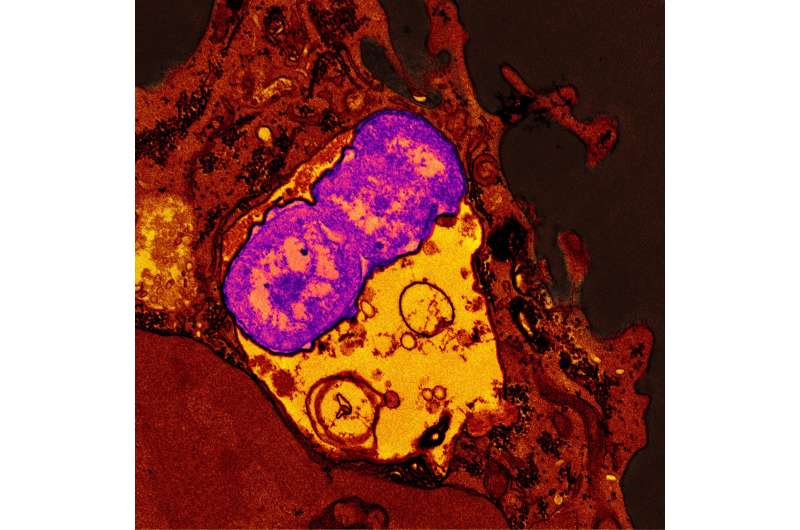This article has been reviewed according to Science X's editorial process and policies. Editors have highlighted the following attributes while ensuring the content's credibility:
fact-checked
peer-reviewed publication
trusted source
proofread
Multidrug-resistant bacterium emerging in community settings

New "hypervirulent" strains of the bacterium Klebsiella pneumoniae have emerged in healthy people in community settings, prompting a National Institutes of Health research group to investigate how the human immune system defends against infection.
After exposing the strains to components of the human immune system in a laboratory "test tube" setting, scientists found that some strains were more likely to survive in blood and serum than others, and that neutrophils (white blood cells) are more likely to ingest and kill some strains than others.
The study, published in mBio, was led by researchers at NIH's National Institute of Allergy and Infectious Diseases (NIAID).
"This important study is among the first to investigate interaction of these emergent Klebsiella pneumoniae strains with components of human host defense," Acting NIAID Director Hugh Auchincloss, M.D., said. "The work reflects the strength of NIAID's Intramural Research Program. Having stable research teams with established collaborations allows investigators to draw on prior work and quickly inform peers about new, highly relevant public health topics."
More than a century ago scientists identified K. pneumoniae as a cause of serious, often fatal, human infections, mostly in people already ill or with weakened immune systems and especially people in hospitals. Over a span of many decades, some strains developed resistance to multiple antibiotics, and became difficult to treat.
This bacterium, often called classical Klebsiella pneumoniae (cKp), ranks as the third most common pathogen isolated from hospital bloodstream infections. Certain other Klebsiella pneumoniae strains cause severe infections in healthy people in community settings (outside of hospitals) even though they are not multidrug-resistant. They are known as hypervirulent Klebsiella pneumoniae, or hvKp. More recently, strains with both multidrug resistance and hypervirulence characteristics, so-called MDR hvKp, have emerged in both settings.
NIAID scientists have studied this general phenomenon before. In the early 2000s they observed—and actively investigated—virulent strains of methicillin-resistant Staphylococcus aureus (MRSA) bacteria that had emerged in U.S. community settings and caused widespread infections in otherwise healthy people.
Now, the same NIAID research group at Rocky Mountain Laboratories in Hamilton, Montana, is investigating similar questions about the new Klebsiella strains, such as whether the microbes can evade human immune system defenses. Their findings were unexpected: the hvKp strains were more likely to survive in blood and serum than MDR hvKp strains. And neutrophils had ingested less than 5% of the hvKp strains, but more than 67% of the MDR hvKp strains—most of which were killed.
The researchers also developed an antibody serum specifically designed to help neutrophils ingest and kill two selected hvKp and two selected MDR hvKp strains. The antiserum worked, though not uniformly in the hvKp strains. These findings suggest that a vaccine approach for prevention/treatment of infections is feasible.
Based on the findings, the researchers suggest that the potential severity of infection caused by MDR hvKp likely falls in between the classical and hypervirulent forms. The work also suggests that the widely used classification of K. pneumoniae into cKp or hvKp should be reconsidered.
The researchers also are exploring why MDR hvKp are more susceptible to human immune defenses than hvKp: Is this due to a change in surface structure caused by genetic mutation? Or perhaps because combining components of hypervirulence and antibiotic resistance reduces the bacterium's ability to replicate and survive in a competitive environment.
As a next step, the research team will determine the factors involved in MDR hvKp susceptibility to the body's immune defenses using mouse infection models. Ultimately, this knowledge could inform treatment strategies to prevent or decrease disease severity.
More information: Frank R. DeLeo et al, Interaction of multidrug-resistant hypervirulent Klebsiella pneumoniae with components of human innate host defense, mBio (2023). DOI: 10.1128/mbio.01949-23


















